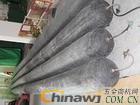The inner membrane used in bridge construction, also referred to as the hollow inner membrane, rubber airbag, hollow core mold, or inflatable bridge mold, has become a widely adopted solution in modern engineering. It gradually replaced traditional materials like bamboo and steel molds, becoming the preferred choice due to its ease of use, durability, and reusability. This type of inner membrane can be reused up to 70-80 times, making it a cost-effective and efficient option for bridge projects.
After each use, it's important to clean the inner membrane thoroughly, release any remaining air, roll it up, and store it in a shaded area away from direct sunlight and sharp objects that could damage the surface. Proper maintenance ensures long-term usability and performance.
To use the airbag inner mold effectively:
1. **Preparation and Application**
Apply a release agent evenly on the outer surface of the inner mold. Then, insert the airbag into the steel reinforcement cage using rope traction, ensuring the inflation valve is positioned outside the structure.
2. **Inflation Process**
Open the air intake valve and inflate the inner mold. Monitor the pressure using a pressure gauge to ensure it reaches the required level. Once the desired pressure is achieved, close the intake valve. For C-shaped molds, alternate the inflation process until the correct pressure is reached. Avoid over-inflating, as this can cause damage.
3. **Fixation and Concrete Pouring**
During concrete pouring, the inner mold may float upward, so it must be securely fixed in all directions. Typically, the stirrup spacing for a 250mm core mold is around 80cm. If the diameter increases, the spacing should be reduced accordingly. When pouring concrete, follow standard procedures, but pay special attention to using high-frequency vibrators to prevent displacement of the inner mold. Avoid touching the end of the vibrator rod directly against the mold.
4. **Demolding**
Once the concrete has set, open the valve to release the air and carefully remove the inner mold. The demolding time depends on the type of cement used and the ambient conditions.
5. **Cleaning and Storage**
After removal, rinse the inner mold thoroughly and perform a water test to check for leaks. Store it properly to ensure it remains in good condition for future use.
This innovative technology plays a crucial role in modern bridge construction, offering efficiency, flexibility, and reliability. Whether for small-scale projects or large infrastructure developments, the airbag inner mold continues to prove its value in the field.
Content sourced from http:// If you wish to reproduce, please cite the original source.


Countersunk Peel Type Blind Rivets
Countersunk Peel Type Blind Rivets,Peel Type Blind Rivets,Peel Type Blind Rivets Of Countersunk,Countersunk Peel Type Blind Rivet
TIANCHANG FASTENER SYSTEM CO..LTD , https://www.toprivet.com